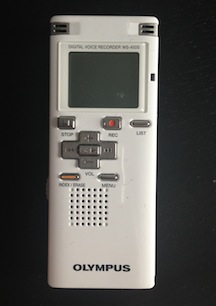Review: Olympus WS-450S digital voice recorder
As a transcriber, I have but one requirement when it comes to voice recorders: Please, oh please, produce perfect quality audio recordings so that I can understand exactly what every speaker is saying.
As a researcher, I have quite a few more requirements on my tick list. I've been using the Olympus WS-450S recorder for several years now, and it's worked brilliantly for my needs. Colleagues of mine have used much fancier, higher end recorders with far more bells and whistles, but in my opinion it's simply not worth it, particularly for researchers who are less technically minded. More options just add to more frustration and more chance of losing vital recordings. For instance, my colleagues' recorders have a voice that tells you which options are currently showing up (I assume this is for blind people, but none of my colleagues has figured out how to turn it off, which makes it awkward at the beginning of interviews when the recorder is telling the room, "List! Folder 1! Folder 2! Record!")
Olympus WS-450S digital voice recorder
I've tried to write this as non technically as possible - consider it "Audio Recorders for Dummies".
The WS-450S is an older model (I believe the new version is the 650-S) but I think my comments about why it's a great device should be helpful in choosing any audio recorder for research interviews.
Memory: The WS-450S has a memory of 1gb, which the website says can offer up to 272 hours of recordings. However, I've just checked my own recorder which currently has 30 recordings - a total of 9 hours - and the memory is half full. I'm assuming this is because I've been recording WMA files and that if I switched to MP3 I'd get a lot more out of it. This is definitely something to take into consideration, because at one point when I was interviewing a lot and not always deleting the files when I backed them up on my computer, I did run out of memory in the middle of an interview, which was not ideal! Luckily, it did beep loudly to alert me that the memory was almost full, so I could briefly pause the interview, delete some files, and start again. The good news is that it looks like the newer version has double the memory capacity.
Recording: This could not be simpler: Click the record button. Click stop to stop recording. The beauty of this device is that it's impossible to record over old audio (the constant fear with the tape recorders of the past). The recorder also works like your average USB memory stick - so recordings are filed into folders, which you can rename when the device is plugged into your computer. Which brings me to my next point...
Uploading your audio: One of the great things about this audio recorder (and many of the other Olympus recorders) is the built-in USB connectivity. The recorders my colleagues have been working with require an external USB cord, which I find really irritating to have to deal with. This recorder is basically just like a large, multi-functional USB drive.
The biggest downside to the WS 450-S is the "hold" switch, which I think is really poorly designed (my colleagues' model also has the same problem). The only way to turn the recorder fully off and lock the buttons so you're not accidentally pocket recording is by switching this hold switch. Unfortunately, this very easily switches back when the recorder it floating around in your bag or your pocket. I'm not sure whether this is a fault which has been fixed on newer models, but it's something to look out for.
I honestly think this is all we, as researchers, need to worry about when it comes to audio recording: How to record, how the files are stored on the device, and how to get the files off of the device. There's no reason to overcomplicate things. The WS 450-S has two recording modes (as you can see above) - conference or dictate - but I think I've always used "conference" mode. I've recorded in a variety of settings - normal one on one in-person interviews, telephone interviews with my phone on speakerphone, focus groups/ meetings - and as long as I've followed my own 5 Rules for Audio Recording (coming soon!) I get clear, crisp audio recordings that are easy to transcribe.






